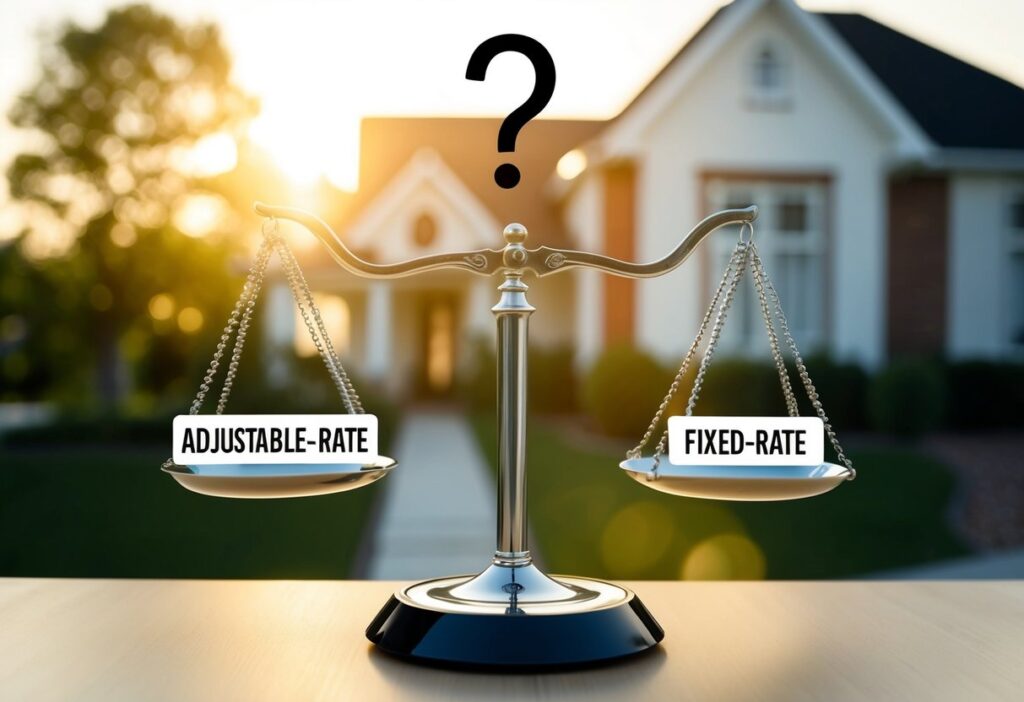Anúncios
Buying a home often means getting a mortgage. But which type should you choose?
Many people wonder about the differences between adjustable-rate and fixed-rate mortgages.

The right mortgage choice depends on your financial situation, how long you plan to stay in the home, and your comfort with changing payments.
Fixed-rate mortgages keep the same interest rate for the entire loan period, while adjustable-rate mortgages start with lower rates that change over time.
Understanding the pros and cons of each option can save homebuyers thousands of dollars over the life of their loan.
This guide will help explain the key differences and show which mortgage type might work best for different situations.
Understanding Adjustable-Rate Mortgages (ARMs)

Adjustable-rate mortgages feature interest rates that change over time based on market conditions. Their structure includes initial fixed-rate periods followed by adjustment periods that can raise or lower your monthly payments.
ARM Interest Rate Composition
The interest rate on an ARM consists of two parts: the index and the margin.
The index is a benchmark interest rate that fluctuates with market conditions, such as the Secured Overnight Financing Rate (SOFR) or the Treasury Bill rate.
The margin is a fixed percentage added to the index to determine your total interest rate. For example, if the index is 2% and your margin is 2.5%, your interest rate would be 4.5%.
ARM rates are typically expressed as “5/1 ARM” or “7/1 ARM.” The first number indicates the initial fixed-rate period in years, while the second number shows how often the rate adjusts afterward, usually annually.
Most ARMs include rate caps that limit how much your interest rate can increase:
- Initial adjustment cap: Limits the first rate increase
- Periodic cap: Limits increases for each adjustment period
- Lifetime cap: Sets the maximum rate for the loan term
Benefits of ARMs
ARMs often start with lower interest rates than fixed-rate mortgages, resulting in smaller initial monthly payments. This can help borrowers qualify for larger loans or save money during the fixed-rate period.
Many homeowners choose ARMs when they plan to sell or refinance before the initial period ends. This strategy works well for those expecting to move within 5-7 years.
If interest rates decline, ARM borrowers may see their payments decrease automatically during adjustment periods. Fixed-rate mortgage holders would need to refinance to benefit from lower rates.
ARMs can be ideal for borrowers expecting increasing income over time. The lower initial payments provide flexibility during early career years when income might be lower.
Risks and Considerations with ARMs
Interest rates may rise significantly after the fixed period ends. Monthly payments could increase by hundreds of dollars, potentially causing financial strain for unprepared borrowers.
Market conditions can be unpredictable over long periods. Even financial experts cannot reliably forecast interest rate movements 5-10 years in the future.
Some ARMs have prepayment penalties if you sell or refinance during specific periods. These fees can amount to thousands of dollars, offsetting potential savings.
Complex ARM terms like rate caps, margins, and adjustment frequencies can be confusing. Misunderstanding these details might lead to unexpected payment increases.
Budget planning becomes more challenging with ARMs due to payment variability. Homeowners must prepare financially for potential rate increases rather than relying on consistent payments.
Exploring Fixed-Rate Mortgages

Fixed-rate mortgages offer predictable payment structures that remain unchanged for the entire loan term. This stability makes them a popular choice for homebuyers who value consistency and long-term planning in their financial lives.
Fixed-Rate Mortgage Structure
A fixed-rate mortgage maintains the same interest rate throughout the loan’s lifetime. Typical terms include 15, 20, and 30 years, with 30-year loans being most common.
Each payment consists of both principal and interest. In early years, most of your payment goes toward interest. As time passes, more goes toward the principal balance.
The amortization schedule shows exactly how each payment is allocated. This predictable structure makes budgeting easier for homeowners.
Payment Breakdown Example:
- Initial years: 70-80% interest, 20-30% principal
- Middle years: 50-60% interest, 40-50% principal
- Final years: 10-20% interest, 80-90% principal
Advantages of Fixed-Rate Mortgages
Protection from rising interest rates is the primary benefit of fixed-rate mortgages. No matter what happens in the economy, your rate stays the same.
This stability makes monthly budgeting more straightforward. Your principal and interest payment remains unchanged for the entire loan term.
Fixed-rate mortgages are simple to understand. The terms are clear and don’t include complex adjustment periods or indexes.
They provide peace of mind during economic uncertainty. When inflation rises, your mortgage payment remains constant while your income potentially increases.
Fixed-rate loans work well for people planning to stay in their homes long-term. The longer you keep the loan, the more valuable the rate protection becomes.
Potential Drawbacks of Fixed-Rate Mortgages
Fixed-rate mortgages typically start with higher interest rates than adjustable-rate options. This means higher initial monthly payments compared to ARMs.
Refinancing costs can be significant if you want to take advantage of lower rates later. Closing costs typically range from 2-5% of the loan amount.
During periods of falling interest rates, fixed-rate borrowers don’t automatically benefit. They must actively refinance to obtain lower rates.
For homeowners planning to move within a few years, the higher fixed rate may not be the most economical choice. The rate premium provides protection you might never need.
The qualification requirements are often stricter for fixed-rate mortgages. Lenders may require better credit scores and lower debt-to-income ratios compared to some adjustable products.
Comparing ARMs and Fixed-Rate Mortgages

When choosing a mortgage, understanding the key differences between adjustable-rate mortgages (ARMs) and fixed-rate mortgages helps borrowers make informed decisions. These two options differ significantly in terms of interest rates, payment predictability, and overall costs.
Interest Rates and Payment Stability
Fixed-rate mortgages offer consistent interest rates that remain unchanged throughout the loan term. This stability means the monthly payment stays the same for the entire mortgage period, typically 15, 20, or 30 years.
ARMs start with lower interest rates than fixed-rate mortgages, creating an initial period of affordability. This introductory rate typically lasts 3, 5, 7, or 10 years before adjustments begin.
After the initial period, ARM rates change based on market indexes. These adjustments can happen annually or more frequently, depending on the loan terms.
Payment changes in ARMs may be significant. For example, a 5/1 ARM with an initial 3% rate could increase to 5% or higher after the fixed period, potentially raising monthly payments by hundreds of dollars.
Most ARMs include rate caps that limit how much the interest rate can change per adjustment period and over the life of the loan.
Long-Term Costs and Predictability
Fixed-rate mortgages provide complete predictability for budgeting. Borrowers know exactly how much they’ll pay each month for the entire loan term.
This predictability comes at a cost. Fixed-rate loans typically have higher initial interest rates than ARMs, resulting in higher initial payments.
Total Interest Comparison Example:
| Loan Type | Initial Rate | 30-Year Total Interest (on $300,000) |
|---|---|---|
| 30-Year Fixed | 4.5% | Approximately $247,220 |
| 5/1 ARM | 3.5% initially, variable after | Varies based on rate changes |
ARMs can save money if the borrower sells or refinances before rate adjustments begin. However, they carry uncertainty about future costs if held long-term.
Market conditions influence ARM costs significantly. In rising-rate environments, ARM payments may increase substantially over time.
Suitability for Different Financial Situations
Fixed-rate mortgages work best for:
- Long-term homeowners planning to stay 10+ years
- People valuing payment predictability
- Borrowers in low-interest-rate environments
- Those with stable income who prefer consistent payments
ARMs typically benefit:
- Short-term homeowners expecting to move within 3-7 years
- Buyers who might refinance before the adjustment period ends
- Purchasers seeking lower initial payments to afford more house
- Borrowers confident in future income increases
A buyer’s financial flexibility matters when choosing between options. Having savings reserves helps manage potential payment increases with ARMs.
First-time homebuyers often prefer fixed-rate mortgages for simplicity and predictability during their transition to homeownership.
Deciding the Best Mortgage Option for You
Choosing between fixed-rate and adjustable-rate mortgages requires careful consideration of your financial situation, future plans, and economic conditions. The right mortgage type varies for each borrower based on several key factors.
Assessing Your Financial Goals
Your long-term financial objectives play a crucial role in mortgage selection. Consider how long you plan to stay in your home. If you expect to move within 5-7 years, an ARM might save you money with its lower initial rate.
Budget stability matters too. Fixed-rate mortgages offer predictable payments that never change, making long-term financial planning easier.
Think about your other financial priorities. Would you prefer lower initial payments to invest elsewhere or pay off other debts? ARMs might free up cash flow initially.
Many homebuyers also consider future income changes. If you expect your income to increase significantly, you might be comfortable with an ARM’s potential payment increases later on.
Evaluating Market Conditions
Current interest rate environments significantly impact mortgage decisions. In low-rate markets, locking in a fixed rate can provide long-term savings.
Interest Rate Trends:
- Rising rate environment → Consider fixed-rate to avoid future increases
- Falling rate environment → ARM might benefit from future decreases
- Flat rate environment → Compare the savings between initial ARM rates and fixed rates
Economic forecasts matter too. The Federal Reserve’s policies and inflation expectations can indicate future rate movements.
Mortgage indexes (like SOFR or Treasury yields) determine ARM rate adjustments. Research which index your potential ARM uses and its historical volatility.
Housing market conditions in your area might also influence your decision if they affect how long you’ll likely stay in the home.
Personal Risk Tolerance and Time Horizon
Your comfort with financial uncertainty directly affects which mortgage suits you best. Risk-averse borrowers typically prefer fixed-rate mortgages for their predictability.
Consider how potential payment increases might affect your financial stability. Could you handle maximum payment scenarios under an ARM’s worst-case adjustments?
Your age and life stage matter too. Younger borrowers with rising careers might accept more risk than those approaching retirement who need payment certainty.
Time horizon is equally important. A 30-year fixed rate provides stability for long-term homeowners, while a 5/1 ARM might work better for those expecting to move or refinance within 5 years.
Look at your overall financial picture. Strong cash reserves and low debt-to-income ratios provide more flexibility to handle ARM rate adjustments.
Consulting with a Mortgage Advisor
Professional guidance can clarify complex mortgage options.
A qualified mortgage advisor can analyze your financial situation and recommend appropriate products.
Ask advisors to calculate payment scenarios showing:
- Initial payments for both mortgage types
- Maximum potential payments under various ARM adjustment scenarios
- Break-even points where one option becomes more advantageous
Good advisors explain loan features beyond rates, such as prepayment penalties, adjustment caps, and conversion options that let you switch an ARM to a fixed rate.
They should also help you understand closing costs differences between options.
Sometimes lower ARM rates come with higher upfront fees.
Independent mortgage brokers can compare options across multiple lenders, while bank loan officers might offer special programs or relationship discounts.